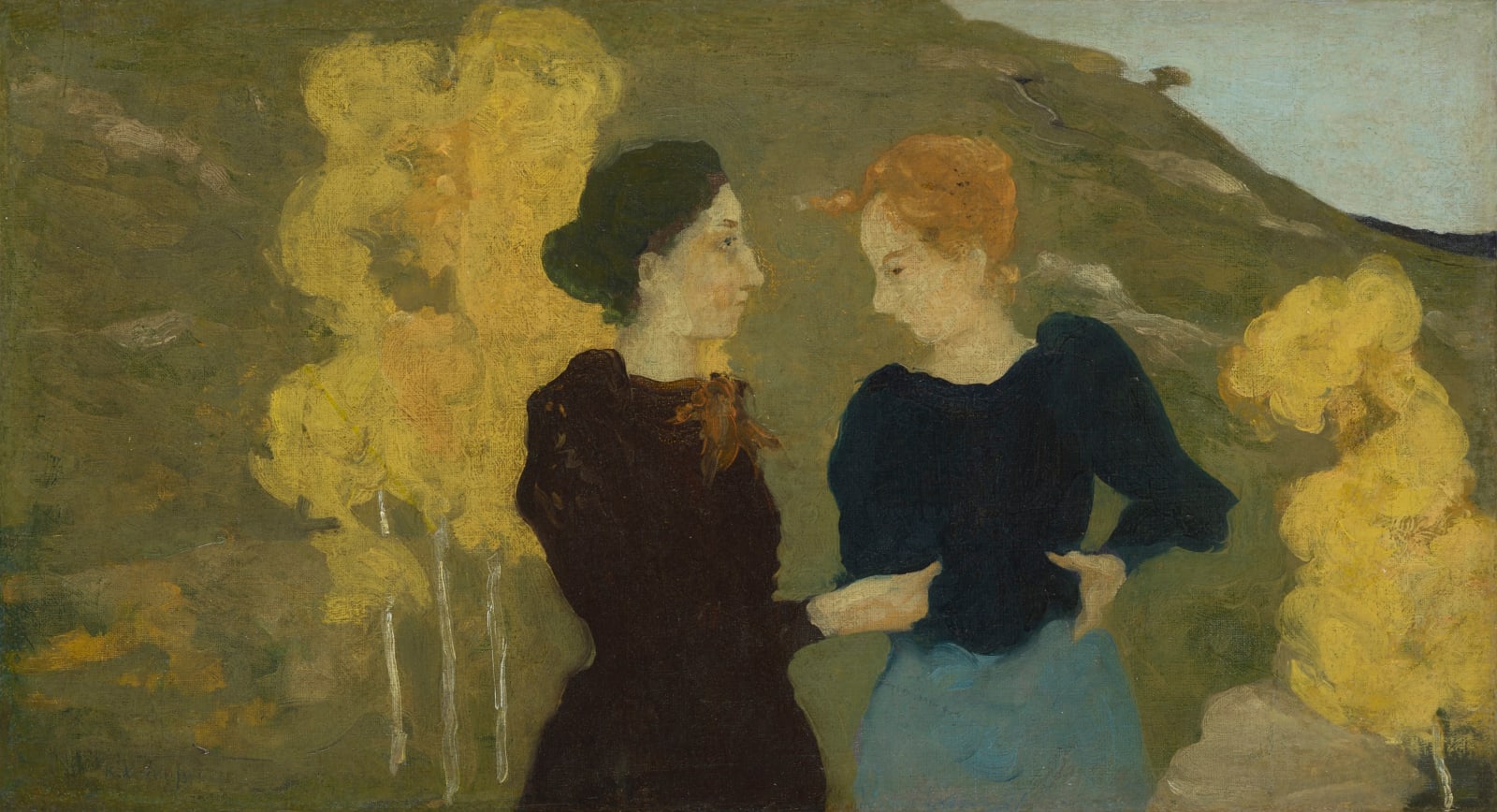Ker-Xavier Roussel (1867–1944)
Composition: Deux femmes ou Deux Âges de la Vie, 1892
Oil on canvas
29 x 52 cm
Signed on the lower left
Copyright The Artist
This work is similar to the two large versions of ‘The Seasons of Life’ in the Musée d'Orsay and the former Josefowitz collection. Smaller in size but with identical proportions,...
This work is similar to the two large versions of ‘The Seasons of Life’ in the Musée d'Orsay and the former Josefowitz collection. Smaller in size but with identical proportions, it evokes the refined and allegorical world of Puvis de Chavannes, as well as Japanese influences.
Even more than the two large versions mentioned above, this one perfectly illustrates Maurice Denis' famous phrase (1890): ’Remember that a painting, before being a battle horse, a naked woman, or any anecdote, is essentially a flat surface covered with colours assembled in a certain order.’
The definition and differentiation of the faces, the yellow trees, which here accentuate the stiffness or, conversely, the movement of each figure, and the treatment of the background, where reliefs are sketched out, are particularly reminiscent of the painting in the Musée d'Orsay.Reduced to half-length and stripped of the clothing details and feminine elegance that catch the viewer's eye in ‘The Seasons’, the figures have moved closer together, perhaps even to the point of physical contact, which is unusual for Roussel at this time. Only the absent gaze of the older woman on the left introduces a psychological distance that contrasts with the attitude of the young woman on the right. While still evoking a theatrical representation, the scene has become more intimate and intense.
Even more than the two large versions mentioned above, this one perfectly illustrates Maurice Denis' famous phrase (1890): ’Remember that a painting, before being a battle horse, a naked woman, or any anecdote, is essentially a flat surface covered with colours assembled in a certain order.’
The definition and differentiation of the faces, the yellow trees, which here accentuate the stiffness or, conversely, the movement of each figure, and the treatment of the background, where reliefs are sketched out, are particularly reminiscent of the painting in the Musée d'Orsay.Reduced to half-length and stripped of the clothing details and feminine elegance that catch the viewer's eye in ‘The Seasons’, the figures have moved closer together, perhaps even to the point of physical contact, which is unusual for Roussel at this time. Only the absent gaze of the older woman on the left introduces a psychological distance that contrasts with the attitude of the young woman on the right. While still evoking a theatrical representation, the scene has become more intimate and intense.
Provenance
Galerie Georges Maratier, étiquette n° 328Collection Léon Nauwinck (violoniste et peintre, ami de Vuillard)
Ses descendants après 1971
Galerie Hopkins-Thomas, Paris
Acquis de celle-ci par l’actuel propriétaire en 1994
Exhibitions
1944, Paris, Galerie Maratier, K-X Roussel, n° 173 (prêté par Nauwinck) 1994, St-Germain-en-Laye, Musée MauriceDenis “Le Prieuré”, K. X. Roussel, n°10, reproduit en couverture du catalogue et sur l’affiche de l’exposition.1998-1999 Budapest, Galerie Nationale Hongroise, Symbolistes français - Gauguin - Pont-Aven Nabis, n° 87, repr page 85 du catalogue.
2011, Musée de Pont-Aven, Ker-Xavier Roussel, le Nabi bucolique, n° 32, repr pages 86-87 2018, Giverny, Musée des impressionnismes, Japonismes Impressionnismes, n° 136 repr page 180
2019, Giverny, Musée des impressionnismes, KerXavier Roussel Jardin privé, jardin rêvé, n° 4 repr page 55
Literature
Claude Jeancolas, La peinture des Nabis, FVW édition, Paris 2002, reproduit p. 72.Connaissance des Arts, p. 46 ; Beaux-Arts Magazine, p. 68 ; Le Journal des Arts, p. 14 ; Côté Ouest, p. 52 ; L’Œil, p. 5
1
of
2
